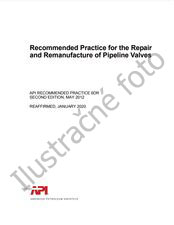Potrebujeme váš súhlas na využitie jednotlivých dát, aby sa vám okrem iného mohli ukazovať informácie týkajúce sa vašich záujmov. Súhlas udelíte kliknutím na tlačidlo „OK“.

API RP 752-ed.4
Management of Hazards Associated with Location of Process Plant Permanent Buildings
NORMA vydaná dňa 1.1.2024
Informácie o norme:
Označenie normy: API RP 752-ed.4
Dátum vydania normy: 1.1.2024
Kód tovaru: NS-1163308
Počet strán: 68
Približná hmotnosť: 204 g (0.45 libier)
Krajina: Americká technická norma
Kategória: Technické normy API
Anotácia textu normy API RP 752-ed.4 :
API RP 752, 4th Edition, January 2024 - Management of Hazards Associated with Location of Process Plant Permanent Buildings
General
This recommended practice (RP) provides guidance for managing the risks from process-related explosion, fire, and toxic material release hazards to personnel located in on-site buildings. This RP covers:
- — new and existing permanent buildings;
- — new and existing portable buildings (other than light wood trailers) intended for perpetual use (intended to be used for the life of the building or life of the process plant) in a specific, fixed location.
Annex B provides examples on the coverage of permanent and portable buildings/tents.
This RP was developed for use at refineries, petrochemical and chemical operations, natural gas liquids extraction plants, natural gas liquefaction plants, and other onshore facilities, such as those covered by the Occupational Safety and Health Administration (OSHA) process safety management regulation, 29 CFR 1910.119 [1].
Non-process-related hazards exist that could present risks to building occupants including, but not limited to, fires originating from within the building, structural collapse due to extreme weather/seismic events, and objects falling on or striking the building. These non-process-related hazards are addressed by building design standards and applicable building codes/regulations, and are not within the scope of this RP.
Guiding Principles
API has established guiding principles for building/tent siting, which are used in API 752, API 753, and API 756. These guiding principles apply to all buildings and tents intended for occupancy:
- 1) locate personnel away from process areas consistent with safe and effective operations;
- 2) minimize the use of buildings/tents in close proximity to process areas;
- 3) manage the occupancy of buildings/tents in close proximity to process areas, especially during periods of planned abnormal operation with increased risk including, but not limited to, unit start-up, testing, or planned shutdown operations;
- 4) design, construct, install, modify, and maintain buildings/tents to protect occupants from the hazards created by explosion, fire, and toxic material release;
- 5) manage the use of buildings/tents as an integral part of the design, construction, maintenance, operation, and emergency response of a facility.
These guiding principles reflect the concept of the hierarchy of controls. With respect to building hazards, mitigations arranged in a hierarchy, beginning with the most effective, involve:
- — eliminating either the occupancy or the hazards;
- — reducing occupancy or the severity of the hazards;
- — increasing the distance between the occupants and the hazards;
- — increasing the resistance of the building to the hazards;
- — administratively managing the occupancy.
Annex F is provided to summarize a few select events that clarify, illustrate, and emphasize the lessons learned that led to the development of these guiding principles.
Relationship with API 753 and API 756
All portable buildings intended to be movable and all light wood trailers are covered by API 753 [2].
New and existing tents are covered by API 756 [3].
Table B.1 provides examples on the coverage of permanent and portable buildings/tents.
All references in this RP to API 753 and API 756 are to the 2nd Edition of both, which published concurrently with API 752.



 Cookies
Cookies
